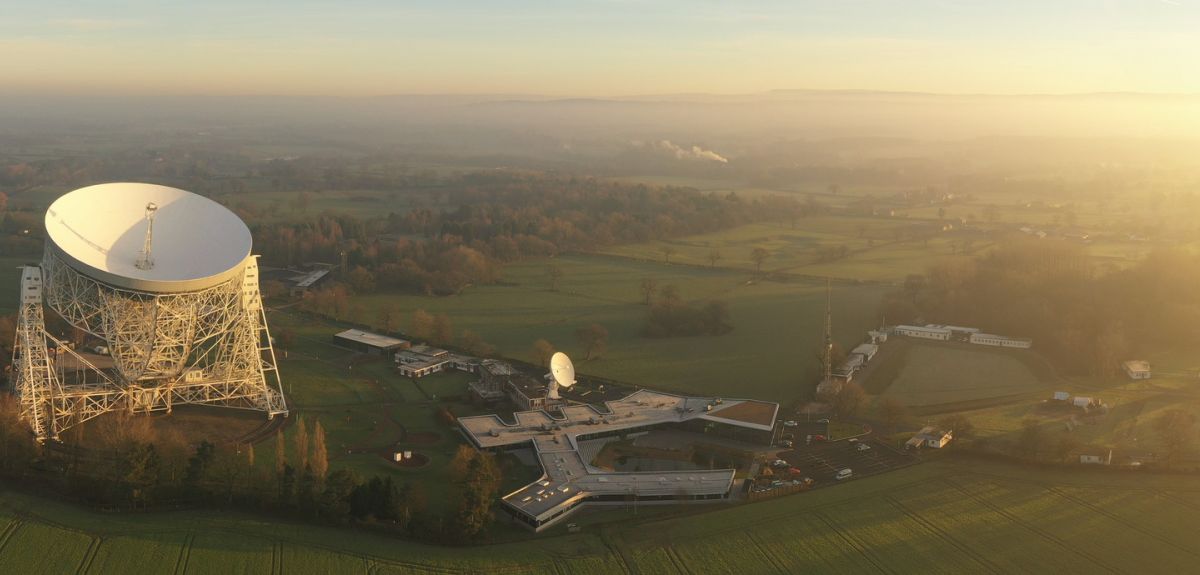
Government gives £15 million to build software and computer systems at the heart of a new international telescope system
- Six institutions, including the University of Oxford, are leading efforts to deliver computational systems that will enable the world’s largest radio telescope.
- A team of physicists from Oxford and Manchester Universities are working together on pulsar and fast radio transient science.
- Oxford e-Research Centre working with industrial partners on fast algorithm development.
- Exciting new discoveries are expected in our galaxy and beyond.
- The Square Kilometre Array Observatory (SKAO) will comprise nearly 200 radio telescope dishes in South Africa and 130,000+ antennas in Australia.
More than £15million has today been awarded to six UK universities and laboratories, for work on what will be the world’s largest radio telescope. Two teams at Oxford will work on the crucial software and computer hardware that will enable SKAO to achieve its scientific goals.
The telescope has a broad scientific remit. It will search for pulsars and fast transients and explore the evolution of the early universe and the earliest processes in fashioning galaxies, such as our own Milky Way. SKAO will oversee the delivery and operations from its headquarters in the UK.
Funds have been awarded through the Government’s Science and Technology Facilities Council and, alongside Oxford, recipients are: the Universities of Cambridge and Manchester as well as STFC’s Rutherford Appleton Laboratory (RAL), Harwell Campus, Daresbury Laboratory, Liverpool City Region, and Astronomy Technology Centre, Edinburgh.
To enable SKAO, we will need to overcome some of the largest computational challenges mankind has faced so far
Professor Wes Armour
The High Performance Computing and Code Optimisation team, based in the Oxford e-Research Centre (OeRC), Department of Engineering Science, will work with partners such as NVIDIA and Intel to deliver the building blocks that will enable data processing at the extreme data rates produced by SKAO.
Professor Wes Armour, Director of the OeRC explains, ‘To enable SKAO, we will need to overcome some of the largest computational challenges mankind has faced so far. The volumes and velocities of raw data produced by the telescope and the level of complex processing required to extract interesting scientific results are unprecedented. Specialised software, supercomputers and new computational algorithms must be developed to process data at rates far greater than the current global internet traffic.’
Dr Karel Adamek, Oxford team lead, adds, ‘Our team, called HIPPO, specialises in High Performance Computing and Code Optimisation. Using our expertise in algorithm development and GPU computing, we will contribute fundamental software allowing SKAO to realise its scientific potential.’
The HIPPO team is part of the wider scientific computing group based in the Oxford e-Research Centre and will leverage the teams’ wider skills in digital signal processing, high performance computing and machine learning to help achieve SKAO’s ambitious goals.
The pulsar and fast-transients team, from a collaboration between physicists in Oxford and Manchester, is mapping our astrophysical understanding onto cutting-edge computer hardware, such as GPUs and FPGAs, to identify and analyse signals from pulsars and fast radio transients.
Professor Aris Karastergiou, from Oxford’s Department of Physics, says, ‘The pulsar and fast transients machine will deliver one of the major science goals of the telescope. It will provide a route to many interesting discoveries.’
We think we will find new rare examples of binary systems to test Einstein’s General Relativity, potentially even a pulsar orbiting a black hole
Professor Aris Karastergiou
He explains, ‘The SKAO will rely on high performance computers to achieve its scientific aims. Together with colleagues at Manchester we are developing the software that will allow some exciting discoveries - for instance, we are aiming to discover every radio pulsar in our galaxy beaming towards Earth. We also expect to find and characterise new Fast Radio Bursts, and hope to solve some of their mysteries.’
‘And’, he says with excitement, ‘we think we will find new rare examples of binary systems to test Einstein’s General Relativity, potentially even a pulsar orbiting a black hole’.
Professor Karastergiou continues, ‘We have the privilege of working on fundamental science that stimulates the imagination. The project allows us an opportunity to consider the place of humankind in the universe, at a bleak time.’
As well as providing the foundation for new galaxy-level discoveries, this award will help to guarantee future contracts for UK industry...This reflects the incredible skill of our science community
Science Minister George Freeman
The UK Government, through STFC, is the largest contributor to the SKAO and, currently, has a commitment to support 15% of the total cost of construction and initial operations from 2021 to 2030.
Science Minister George Freeman said, ‘It is no surprise that the UK’s outstanding scientists are playing such a vital role in shaping the future of this cutting-edge global observatory, backed by £15 million government funding.
‘As well as providing the foundation for new galaxy-level discoveries, this award will help to guarantee future contracts for UK industry, secure skilled jobs and develop a highly-transferrable technology in the UK – channelling more money back into the UK economy.
‘This reflects the incredible skill of our science community, who are working hand-in-hand with industry to ensure the UK continues to grow as a global science superpower.’
 Expert Comment: Chatbot-driven sexual abuse? The Grok case is just the tip of the iceberg
Expert Comment: Chatbot-driven sexual abuse? The Grok case is just the tip of the iceberg
 New study finds that stopping weight-loss drugs is linked to faster regain than ending diet programmes
New study finds that stopping weight-loss drugs is linked to faster regain than ending diet programmes